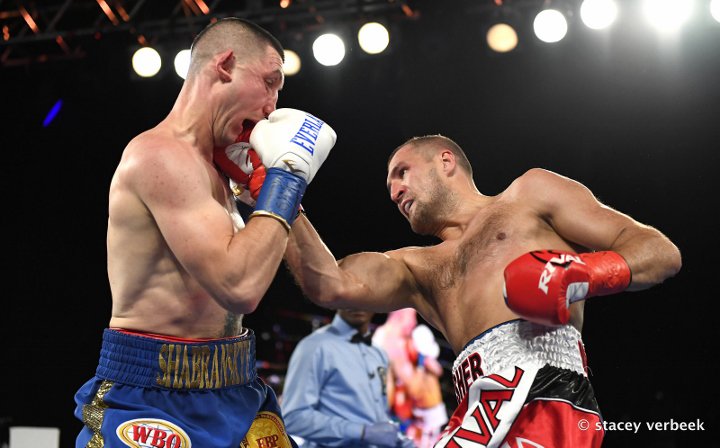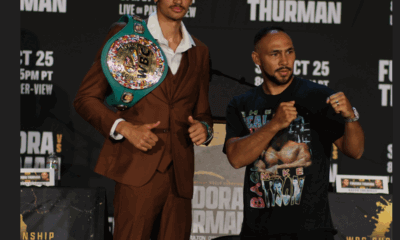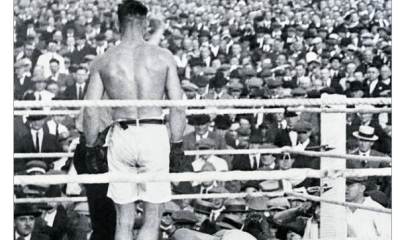Canada and USA
The Hauser Report: Sergey Kovalev and More at Madison Square Garden
November 25 marked the start of a unique fifteen-day period. The current Madison Square Garden opened in 1968. This will be the first time

HBO’s triple-header at Madison Square Garden on November 25 marked the start of a unique fifteen-day period. The current Madison Square Garden opened in 1968. This will be the first time ever that the building has hosted boxing in three consecutive weeks.
The November 25 card was built around 32-year-old Sergey Kovalev, who held the WBA, IBF, and WBO 175-pound titles until losing a disputed decision to Andre Ward in November 2016. Seven months later, Ward stopped Kovalev in round eight of a rematch.
Thereafter, Kovalev and trainer John David Jackson parted ways on less than good terms. Among the thoughts that Jackson offered on the separation were:
* “Sergey said a couple of things. He’s blaming me for the loss. But you can’t blame me for your loss when you quit. He quit! Once Andre started hitting him to the body, he was done.”
* “Sergey and I have been going through stuff for years because he’s a real asshole. All the Russians that I’ve trained, they’re wonderful people. This guy is a complete dick. Sergey started making money, getting big headed, and he didn’t want to train hard anymore. Every camp was worse and worse.”
* “If he comes back, he’s damaged goods. He would probably beat a couple of guys, but now they know your secret. You can’t take it to the body. You’re in trouble.”
Kovalev, for his part, responded, “The whole time I worked with John David Jackson, I got nothing from him except mitts work. I don’t want to say any bad words. He’s a nice guy, but he’s not the coach for me. A coach should help you inside the ring in between rounds when you have one minute for rest. He should say tactics, how to open the target or move to the left or right or back or forward. Because emotions and adrenaline of every fighter inside the ring is very high, fighters don’t see a lot of things [trainers] can see from the side.”
When Kovalev returned to action on Thanksgiving weekend, it was with a new trainer (Arbor Tursunpulatov) and, he professed, a new attitude.
“Life showed me that I should be more concentrated on my boxing career if I want to do this,” Sergey told the media. “I cleaned up my body and I cleaned up my mind from zero. All life is like a lesson for me. Right now, I feel all bad things are gone from my mind.”
Asked about what some thought was a premature stoppage in the Ward rematch after Andre hit him with several illegal low blows, Kovalev answered, “Better for me if Ward knocked me out to close the questions. The Ward fight was like a bad dream. Now I am awake again and must go on with my boxing career. What happened happened. Everything is good. I’m ready to get new fights and new belts again.”
Kovalev’s opponent on November 25, Vyacheslav Shabranskyy, had questionable credentials and a knockout loss to Sullivan Barrera on his ring ledger. Initially, Kovalev-Shabranskyy was scheduled for ten rounds. Then, on September 21, Andre Ward announced his retirement, freeing up the WBA, WBO, and IBF belts. On October 26, the WBO decreed that Kovalev-Shabranskyy would be for its175-pound title.
The fight was contested in The Theater at Madison Square Garden. The announced attendance of 3,307 included more than a few giveaways. The crowd was flat to begin with. And an interminably long wait before the televised fights began (during which loud music that didn’t appeal to any on-site demographic blared) didn’t help matters.
A super-featherweight match-up between Jason Sosa and Yuriorkis Gamboa was first up on HBO.
A “boring” fight isn’t boring to the fighters involved. Their health and economic future are on the line. They’re trying to beat another man senseless and, at the same time, trying to survive.
That said; Sosa-Gamboa was boring. The fans in attendance could have been sitting in a movie theater watching a documentary about pottery-making for all the noise they made.
Gamboa was a shooting star who now looks to be shot. The speed and explosive power that once marked his performances are gone.
Sosa is a one-dimensional fighter who reported to training camp thirty pounds above the contract weight and wasn’t in shape to push the action for ten rounds. But Jason did some good body work from time to time and made the fight such as it was.
Referee Ron Lipton made the correct call in two knockdown situations: first, in round three when Gamboa tumbled to the canvas after being hit by a hook to the body and tripped over Sosa’s foot; and again, in round seven when Yuriorkis’s glove touched the canvas as a consequence of his having been wobbled by a clean punch.
But Lipton has a tendency to insert himself into fights more than necessary. Gamboa held half-heartedly throughout the bout. Sosa could have punched his way out, which would have kept the action flowing. Instead, again and again, Lipton physically broke the fighters, which meant that Gamboa had more time to regroup and was incentivized to keep holding.
The consensus at ringside was that Sosa was a clear winner by a margin in the neighborhood of six points. Judge Robin Taylor’s scorecard was the first to be announced.
94-94.
That elicited a chorus of boos from the few fans who had been engaged enough to actually watch the fight.
Then Michael Buffer read the scorecards of John McKaie (95-93) and Don Trella (96-92).
For Gamboa.
Picture a fastball that bounces in the dirt three feet in front of home plate and is called “strike three” by the umpire. That was the judging in Sosa-Gamboa. The New York State Athletic Commission could have taken three people at random out of the crowd and they would have done a better job.
The next fight – a light-heavyweight match-up between Sullivan Barrera and Felix Valera – was a sloppy foul-filled affair. Referee Mike Ortega deducted three points from Valera and one from Barrera for low blows. This time, three different judges got it right, scoring the contest 98-88, 97-90, 97-89 for Barrera.
Then it was time for Kovalev-Shabranskyy.
Kovalev was a 12-to-1 betting favorite. For good cause. One minute forty seconds into round one, he dropped Shabranskyy with an overhand right. Vyacheslav rose quickly and, a minute later, was on the canvas again courtesy of a clubbing right hand followed by a left hook.
Round two was more of the same. Fifteen seconds into the stanza, another right over the top shook Shabranskyy. Just before the two minute mark, an accumulation of punches put him on the canvas for the third time. He rose. Kovalev pummeled him around the ring some more. And referee Harvey Dock waved off the action at the 2:36 mark.
There are some good fights to be made now at 175 pounds. If boxing were a well-run sport, fans would see a four-man elimination tournament with Kovalev, Artur Beterbiev, Oleksandr Gvozdyk, and Dmitry Bivol to determine who’s the best 175-pound fighter in the world. Adonis Stevenson, who in recent years has shown no interest in fighting elite opposition, could be the alternate. That way, Stevenson could continue to talk about going in tough and continue to not go in tough.
Boxing is not a well-run sport.
And a closing note on the November 25, 2017, festivities at Madison Square Garden.
Prior to Sosa-Gamboa, Michael Buffer introduced Ron Lipton with the words, “Inside the ring, in charge of the action at the bell, referee Ron Lipton.”
Later, in introducing Harvey Dock who was the third man in the ring for Kovalev-Shabranskyy, Buffer proclaimed, “When the bell rings, the man in charge of the action, your referee, world championship veteran Harvey Dock.”
As Buffer was leaving the arena at the end of the night, Lipton approached him and complained about the introductions, saying, “How could you introduce us like that? He doesn’t have my experience. I started refereeing before he did. I’ve done more championship fights than he has.”
Right now, Harvey Dock might be the best referee in boxing.
Thomas Hauser can be reached by email at thauser@rcn.com. His most recent book – There Will Always Be Boxing – was published by the University of Arkansas Press. In 2004, the Boxing Writers Association of America honored Hauser with the Nat Fleischer Award for career excellence in boxing journalism.
Check out more boxing news on video at The Boxing Channel.
-

 Book Review4 weeks ago
Book Review4 weeks agoMark Kriegel’s New Book About Mike Tyson is a Must-Read
-

 Featured Articles3 weeks ago
Featured Articles3 weeks agoThe Hauser Report: Debunking Two Myths and Other Notes
-

 Featured Articles3 weeks ago
Featured Articles3 weeks agoMoses Itauma Continues his Rapid Rise; Steamrolls Dillian Whyte in Riyadh
-

 Featured Articles3 weeks ago
Featured Articles3 weeks agoNikita Tszyu and Australia’s Short-Lived Boxing Renaissance
-

 Featured Articles4 weeks ago
Featured Articles4 weeks agoKotari and Urakawa – Two Fatalities on the Same Card in Japan: Boxing’s Darkest Day
-

 Featured Articles3 weeks ago
Featured Articles3 weeks agoIs Moses Itauma the Next Mike Tyson?
-

 Featured Articles2 weeks ago
Featured Articles2 weeks agoBoxing Odds and Ends: Paul vs ‘Tank,’ Big Trouble for Marselles Brown and More
-

 Featured Articles2 weeks ago
Featured Articles2 weeks agoAvila Perspective, Chap. 340: MVP in Orlando This Weekend




















